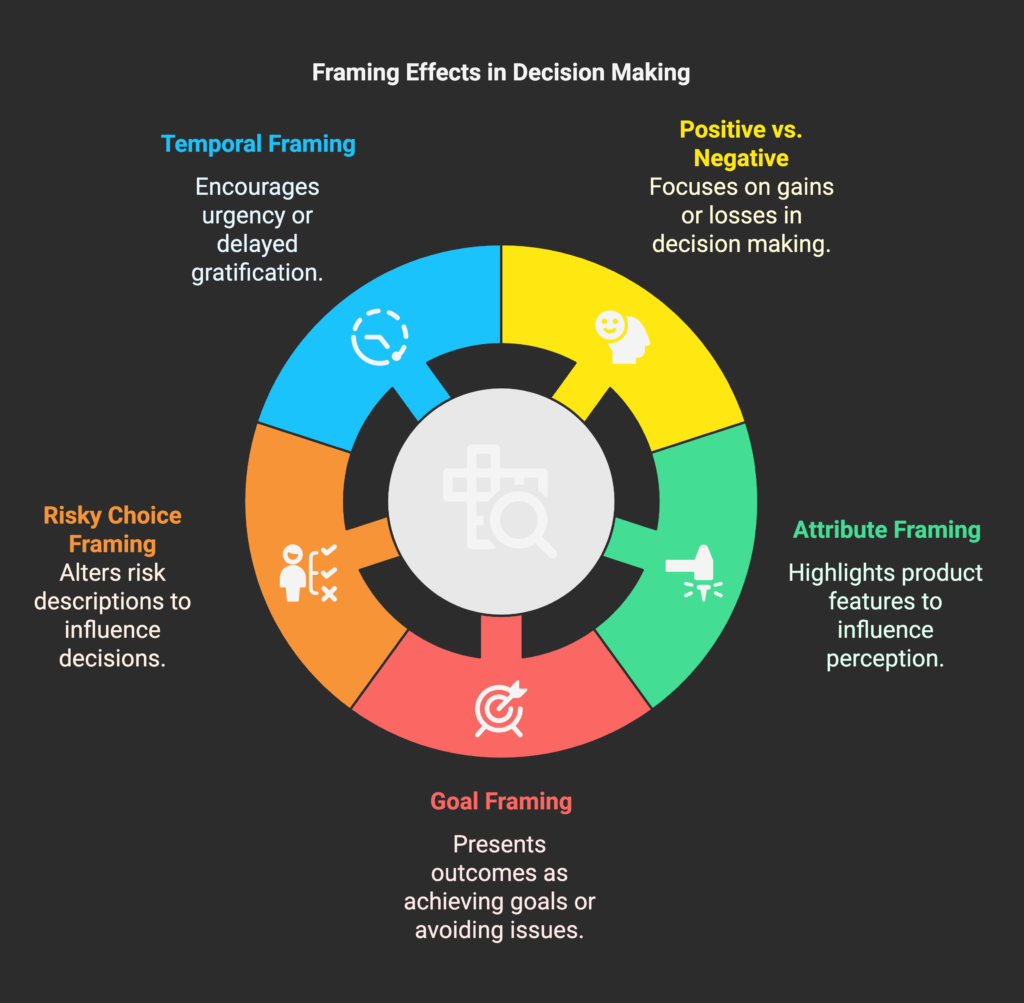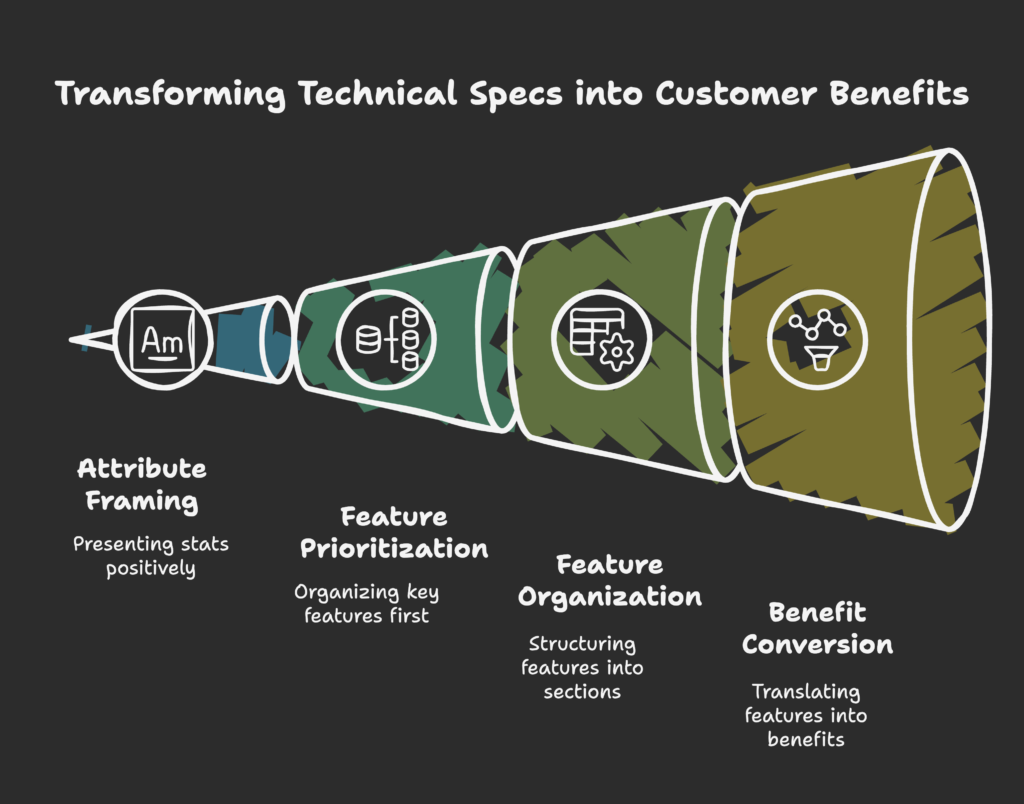Have you ever wondered why a simple twist in words can change how you feel about a product? Or why certain online shops make you think, “I must buy this right now!”? The secret often lies in *how* the product information is presented, rather than *what* the information actually is. That’s the framing effect in action. By the time you finish reading, you’ll know how to use this powerful psychological tool to boost your product descriptions. Ready to dive in? Let’s go!
Introduction to the Framing Effect
In this section, we’ll uncover the basic ideas behind the framing effect. You’ll see its history, discover why it matters so much for e-commerce, and learn what this article will cover. By the end, you’ll understand the foundation of framing and be eager to apply it to your own online store.
Definition and Psychological Foundation
The framing effect is a cognitive bias in which people respond differently to the same information based on how it’s presented. First studied by experts in cognitive psychology, it shows that our brains rely on mental shortcuts (called heuristics) to interpret information quickly. Researchers like Daniel Kahneman and Amos Tversky illustrated how these shortcuts affect decisions (especially in their work on prospect theory).
In simpler terms, if you say a product is “95% effective,” it sounds more appealing than if you say it has a “5% failure rate”—even though they both mean the same thing. This slight change in wording can increase conversions significantly.
Relevance to E-commerce and Product Descriptions
In an online shopping environment, customers can’t touch, feel, or interact with products physically. That’s why framing becomes so important. It bridges the gap between product features and consumer desires, painting a picture of what the item will do for them.
When your marketplace is crowded with similar items, strategic framing helps you stand out. Plus, well-framed product descriptions can have a direct impact on your bottom line. After all, higher conversions mean more sales, more revenue, and more satisfied customers.
Article Scope and Objectives
Here, you’ll find practical framing approaches to make your product descriptions shine. We’ll discuss:
- Different framing types and their psychological roots
- Positive and negative framing strategies for various product categories
- Testing methods to see which frames work best
- Ethical ways to use framing without misleading your customers
Ready to explore the deeper psychology behind how framing works? Let’s move on to the next section!
The Psychology Behind the Framing Effect
In this part, we’ll break down the cognitive processes that make framing so powerful. You’ll learn why certain words or phrases trigger instant reactions and how these can differ among various people. By the end, you’ll see how to adapt your messages for maximum impact.
Cognitive Mechanisms
Your brain has two thinking modes: System 1 (fast, intuitive) and System 2 (slow, analytical). When people shop online, they often rely on System 1 for quick decisions—especially if they’re just browsing or in a hurry. This makes them more susceptible to framing.
Additionally, loss aversion suggests that people dislike losing something more than they enjoy gaining the same thing. That’s why negative framing (focusing on what you might lose) can be so persuasive.
Understanding these mechanisms helps you see why slight tweaks to your descriptions can yield big results. Feeling curious about the different framing types? Let’s keep going.
Types of Framing Effects

There are various ways to frame information:
- Positive vs. Negative Framing: Highlighting gains or emphasizing losses.
- Attribute Framing: Showcasing product features in a favorable light.
- Goal Framing: Presenting outcomes in terms of achieving a goal or avoiding a problem.
- Risky Choice Framing: Influencing decisions by changing how potential risks are described.
- Temporal Framing: Encouraging urgency or delayed gratification based on time-related factors.
Each type can steer customers’ feelings in unique ways. Next, let’s see how different groups of consumers respond.
Consumer Response Patterns
Not everyone reacts to the same frame in the same way. Demographic factors like age or culture can change how consumers perceive product messages. The type of product also matters: high-involvement items (like expensive electronics) might need a different framing approach than low-cost impulse buys.
Cultural background, context, and even the level of personal interest play major roles in determining how effective your framing will be. Now that you know how people process framed messages, it’s time to dive into specific strategies.
Positive Framing Strategies for Product Descriptions
Here, we’ll explore how to highlight positive outcomes in your product descriptions. By the end, you’ll know how to make your items sound irresistible with uplifting language and benefit-centered messaging.
Benefit-Focused Approaches
Positive framing often works best when you focus on *what customers gain.* For instance, instead of saying, “Our shoes are made with lightweight material,” say, “Enjoy effortless walking with our ultra-lightweight design.” This shifts the spotlight onto the benefit (effortless walking) rather than just a feature (lightweight material).
Use images and design elements to reinforce positive emotions. Show happy people wearing or using your product. Make it easy for buyers to imagine themselves experiencing all those wonderful benefits.
Effective Language for Positive Framing
Choosing the right words can spark hope, excitement, or curiosity. Here are some tips:
- Action-Oriented Words: “Achieve,” “Enjoy,” “Transform,” “Boost”
- Positive Phrases: “Feel the difference,” “Get more out of life,” “Experience the best”
- Be Specific: Instead of “improve,” say “improve your morning energy levels by 30%.”
Your goal is to paint a picture of a brighter, more enjoyable life. Let’s see how to apply that in real-world product descriptions next.
Implementation Examples
Imagine a skincare product. A before description might say, “This cream contains vitamin E.” A after version could say, “Experience a radiant glow with our vitamin E-enriched formula that revitalizes your skin day after day.”
A/B tests often show higher click-through and conversion rates when positive framing is used. In many cases, shoppers buy because they feel excited about the transformation they’ll experience.
Positive framing is powerful, but sometimes highlighting what customers *might lose* can be even more motivating. Let’s turn our attention to negative framing next!
Negative Framing Strategies for Product Descriptions
In this section, we’ll see how to emphasize potential risks or losses to create urgency. By the end, you’ll know how to use this approach responsibly, without pushing customers away.
Loss Prevention Approaches
“Don’t miss out” and “Limited time left” are classic examples of negative framing. They focus on what the customer risks losing if they don’t act quickly, such as missing a sale or running out of stock.
Many brands use fear of missing out (FOMO) to accelerate buying decisions. Stress the problem and then offer your product as the solution, making customers feel they’re overcoming a challenge.
Effective Language for Negative Framing
Certain words and phrases trigger a feeling of loss:
- Keywords: “Avoid,” “Stop,” “Never,” “Don’t lose”
- Cautionary Phrases: “Prevent damage,” “Shield yourself,” “Protect your investment”
- Balanced Tone: Provide reassurance alongside the warning. (“Don’t risk faded colors—our fabric guard keeps your clothes vibrant!”)
A bit of worry can be motivating, but be careful not to overdo it or sound manipulative.
Implementation Examples
For a travel insurance plan, a before description might read: “We offer coverage for trip cancellations.” A after version could say, “Don’t let unexpected changes ruin your vacation—stay protected from costly cancellations with our comprehensive plan.”
Studies show that well-executed negative framing can increase conversions when it resonates with the shopper’s concerns. Ready to learn about framing attributes within product specs? Let’s move forward.
Attribute Framing in Product Specifications
Now we’ll focus on framing specific product attributes, like technical details. By the end of this section, you’ll know how to turn even the most complex stats into inviting, easy-to-understand benefits.

Technical Specification Presentation
People often react positively to stats framed as successes rather than failures. Saying a battery is “95% efficient” can sound more impressive than “5% inefficiency.” You can also compare with competitors, highlighting how yours is “twice as durable.”
Use visuals like comparison charts or bold text to emphasize the advantages. When done right, attribute framing builds immediate trust and clarity.
Feature Prioritization and Organization
Group important features at the top where customers will see them first. Or break them into sections such as “Performance,” “Comfort,” or “Durability” based on what buyers care about most.
If there are many specifications, reveal them progressively (like expandable sections). This keeps your page clean but still informative.
Converting Features to Benefits
The Feature-Advantage-Benefit (FAB) method transforms raw data into customer-focused statements. For instance, a laptop with a “2.6 GHz processor” becomes a device that “lets you run multiple apps smoothly, so you can finish tasks faster.”
Ask yourself, “So what?” after each feature. This helps you translate specs into real-life improvements. Now, let’s see how to apply these tactics across different product types.
Practical Implementation Across Product Categories
Here, we’ll explore category-specific ways to frame your products. By the time you finish, you’ll have lots of practical ideas for fashion, electronics, home goods, and more.
Fashion and Apparel
Use material framing to highlight comfort and sustainability. Say “Breathe easy all day with our lightweight cotton blend” instead of just listing the fabric.
Focus on fit and sizing by emphasizing how it compliments different body types. Show style and trend positioning: “Look effortlessly chic this season while staying comfy in our signature cut.”
Ready for some tech talk next? Let’s move on!
Electronics and Technology
Frame performance details by showcasing speed, reliability, and future-proofing. “Enjoy lightning-fast loading times and never worry about lag again” can be more convincing than simply listing “8GB RAM, 256GB SSD.”
For durability, highlight what customers *avoid*: “No more cracked screens!” or “Never suffer sudden shutdowns during important tasks!”
Next, we’ll see how home and lifestyle products can benefit from framing, too.
Home and Lifestyle Products
Make your customers picture a cozy environment or a stress-free routine. For example, a sofa can be described as “Experience true relaxation with plush, sink-in cushions designed for ultimate comfort.”
If space optimization is key, phrase it as a solution to a common pain point: “Free up your living space with our compact yet stylish design.”
Curious about applying framing to food items? Let’s keep going.
Food and Consumables
Paint a tasty picture: “Savor the rich, velvety flavor that turns ordinary mornings into gourmet experiences.” Highlight nutritional benefits positively: “Fuel your day with essential vitamins.”
You can also frame it by origin—“Farm-fresh ingredients from local growers”—to meet the growing demand for transparency. Time to see how all this can be tested for the best results.
Testing and Optimization Frameworks
Here, we’ll learn how to test different frames and track the outcomes. By the end, you’ll know which metrics matter and how to perform A/B or multivariate tests to find the most effective approach.
A/B Testing Methodologies
For a framing test, keep all variables (like images and layout) the same except the specific words you want to test. If you change too many elements at once, you won’t know what caused any improvements or declines.
Aim for enough traffic to reach statistical significance. This ensures your results aren’t just random. Run tests in parallel if possible, so external factors like seasonality affect both versions equally.
Key Performance Indicators
Look at:
- Conversion Rate: How many viewers end up purchasing
- Time on Page: Are people spending more time reading your description?
- Cart Abandonment Rate: Do fewer shoppers leave items in their cart?
- Average Order Value (AOV): Are they buying more items or higher-priced products?
Combined, these metrics paint a complete picture of framing success. Want to test multiple framing ideas at once? Let’s see how multivariate testing helps.
Multivariate Testing for Complex Framing
Multivariate tests let you experiment with several framing elements together: headlines, bullet points, images, and more. You can then identify which combination performs best.
Be sure to segment your audience. Different groups might respond differently to positive or negative frames. Now let’s look at how framing changes based on the channel or platform.
Channel-Specific Framing Considerations
In this section, we’ll look at how to adapt framing for mobile users, online marketplaces, and social commerce. By the end, you’ll be equipped to optimize your descriptions on any platform.
Mobile versus Desktop Presentation
Mobile shoppers have shorter attention spans and smaller screens. Use concise, eye-catching framing. Break text into short paragraphs or bullet points.
Progressive disclosure (toggling sections open) works well on mobile. It keeps pages clean while offering more detail to those who want it.
Marketplace versus Direct-to-Consumer Framing
Marketplaces like Amazon or eBay often limit how you structure your listings. Focus on the framing you can control, like product titles and bullet points.
On your own website, you have the freedom to design the entire layout. Keep your messaging consistent across all platforms to build trust and brand recognition.
Social Commerce Integration
When selling through social media, fast and engaging content is key. Use user-generated content (UGC) to reinforce framing. For instance, show real people benefiting from your product in a quick video or caption.
Now that you know how to tailor framing by channel, let’s consider the ethical side.
Ethical Considerations in Framing
Persuasion is powerful. In this part, we’ll learn how to use it ethically. You’ll see why honesty and inclusivity matter—and how your long-term success depends on trust.
Transparency and Honesty
Persuasive framing should never cross into deception. Clearly show what your product can and cannot do. Avoid misleading claims. Over time, ethical framing earns loyal customers and reduces returns or complaints.
Inclusive and Accessible Framing
Use respectful language that doesn’t exclude any group. Be mindful of cultural sensitivities. Also consider visual accessibility, like using high-contrast colors and alt text for images. Everyone deserves a clear understanding of your products.
Sustainable Framing Practices
Long-term relationships with customers matter more than one-time sales. If you promise too much and fail to deliver, customers won’t come back. Keep your framing realistic while highlighting real benefits.
So how will framing evolve as technology advances? Let’s find out.
Future Trends in Product Description Framing
Here, we’ll look at emerging technologies like AI, augmented reality, and voice commerce. By the end, you’ll see how framing might shift as new tools become available.
AI and Personalization
AI can dynamically change product descriptions based on user data. If someone values sustainability, the AI might highlight eco-friendly aspects. If another values speed, it might stress how fast shipping can be.
As personalization grows, so do ethical considerations. Automated framing must stay transparent and avoid manipulative tactics.
Visual and Interactive Framing
Interactive elements such as 360-degree product views, videos, or augmented reality can reinforce key frames. Imagine letting customers see themselves virtually “trying on” an outfit. That level of immersion can boost confidence in purchases.
Voice Commerce and Conversational Framing
Voice assistants introduce new challenges: customers can’t see visuals, so your product descriptions must rely on concise, persuasive speech. Brands that master audio-based framing can stand out in this growing field.
Next, we’ll wrap it all up with some strategic tips for successful implementation.
Conclusion: Strategic Implementation
In this final section, we’ll put it all together: how to assess your current framing, plan improvements, and strengthen your organization’s skills. By the end, you’ll have a clear roadmap to optimize your product descriptions.
Implementation Roadmap
1. Assess your existing descriptions for how they use (or fail to use) framing.
2. Prioritize areas for improvement, starting with high-impact pages or products.
3. Test different frames using A/B or multivariate methods.
4. Measure using KPIs like conversion rates, average order value, and cart abandonment.
5. Refine and optimize continuously.
Building Organizational Capability
Train your content creators in framing basics. Develop company-wide guidelines and templates for consistent messaging. Collaborate with marketing, design, and data teams to keep testing and adapting.
Remember, framing isn’t just a one-time project; it’s an ongoing process that evolves with consumer behavior and technology.
References
- Plytix. (n.d.). How to Use the Framing Effect to Sell More Products.
- Scribbr. (2022, December 7). What Is the Framing Effect? | Definition & Examples.
- Investopedia. (n.d.). Framing Effect: What It Is and Examples.
- Develop Diverse. (n.d.). Framing effect – Learn everything you need about framing bias.
- Newristics. (n.d.). Definition, Example & How Framing Effect Works.
- Renascence. (2024, August 1). Framing Effect: Shaping Customer Experience Through Strategic Presentation.
- ResearchGate. (2024, October 22). Event-related potentials evidence of the attribute framing effect.
- JSTOR. (n.d.). How Consumers are Affected by the Framing of Attribute Information Before and After Consuming the Product.
- Kahneman, D., & Tversky, A. (1979). Prospect Theory: An Analysis of Decision under Risk.
- Levin, I. P., Schneider, S. L., & Gaeth, G. J. (1998). All Frames Are Not Created Equal: A Typology and Critical Analysis of Framing Effects.
Quick reminder for Shopify store owners: If you want to boost sales even more, check out the Growth Suite app. It offers helpful tools to analyze your performance, refine your marketing, and turn all these framing tips into higher revenue!
Also don’t forget to check The E-commerce Conversion Booster: Mastering Pricing & Presentation Psychology guide.




